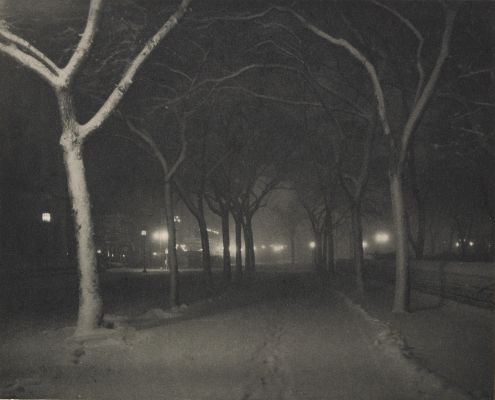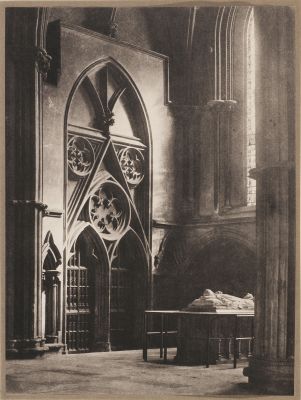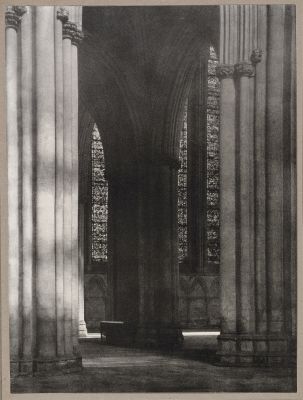
Title
Ely Cathedral: Across Nave and OctagonArtist
Evans, Fredrick (British, 1853-1943)Publication
Camera Work IVDate
1903Process
PhotogravureAtelier
J.J. Waddington, LondonImage Size
14.7 x 18.6 cm
Evans’s best-known works are his photographs of the cathedrals of England. In contrast to the sharply rendered detail of the commercial views of these sites, which were abundantly available, Evans built his images on the parallel foundations of photography and architecture: light and stone. Indeed, Evans believed one of the great failings of most architectural photographs of his time was that they took architecture rather than light as their primary subject. In Ely Cathedral, rather than attempt a literal depiction, Evans selected two large columns to convey the massive presence of this medieval monument. His understanding of light manifests itself in his printing in a way that is both counterintuitive and masterful; instead of printing his picture very dark, which would have further emphasized the weight and mass of the columns, Evans created an image of light greys in which the weight of the stones dissolves, subtly capturing the clerestory light washing the cathedral’s interior in a lengthy exposure. [1]
Reproduced / Exhibited
Kruse, Margret. Kunstphotographie Um 1900: D. Sammlung Ernst Juhl; Hamburg: Museum für Kunst u. Gewerbe, 1989 pl. 426
Nordström, Alison D, Thomas Padon, and J L. Ackerman. Truthbeauty: Pictorialism and the Photograph As Art, 1845-1945. Vancouver, B.C: Douglas & McIntyre, 2008. Print. p
Peterson, Christian A. Camera Work: Process & Image : [exhibition, Minneapolis, Minneapolis Institute of Arts, August 31-November 3, 1985, Seattle, Seattle Art Museum, November 22, 1985-February 2, 1986]. Minneapolis: Minneapolis Institute of arts, 1985. p. 55.
Witkin , London, and Shestack. The Photograph Collector’s Guide. London: Secker & Warburg, 1979. p. 104
References
[1] Nordström, Alison D, Thomas Padon, and J L. Ackerman. Truthbeauty: Pictorialism and the Photograph As Art, 1845-1945. Vancouver, B.C: Douglas & McIntyre, 2008. p. 38







